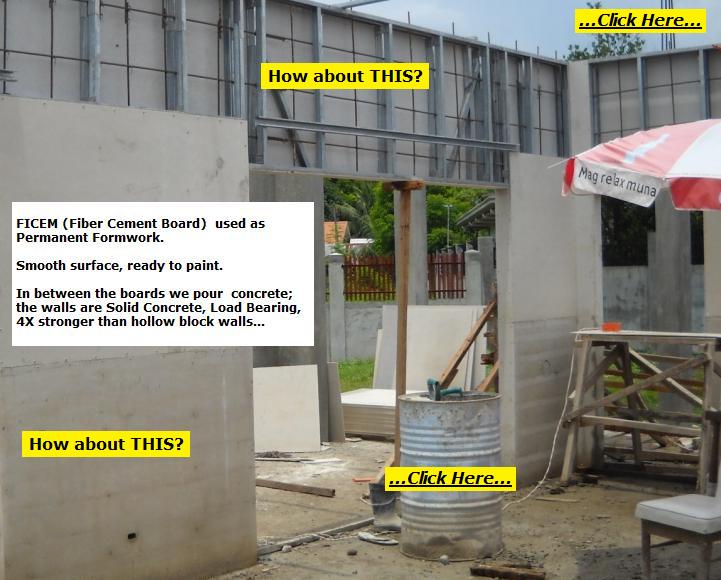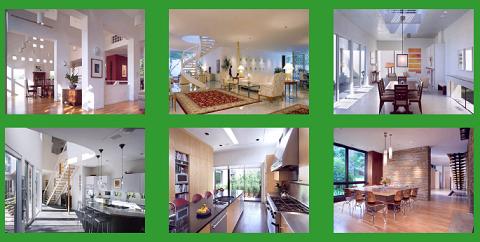| |
Philippine
Construction Cost
...In Cebu we
build at a GUARANTEED LOWEST COST...
The cost to build your house in the
Philippines (or commercial building) depends on the exact location
(is it possible to use a truck to bring the materials or do they have to be
carried?), total floor area (make the house 2x bigger and the price will
become 2x higher), the logistics/accessibility (city or province or
island?), regulations/restrictions of the local government or subdivision
('they all have their own rules'), soil-type, site preparation
(maybe backfill or retaining-wall?) neighbor-buildings, availability
of local skilled labor, source of electricity/water etc. plus you
have to select
what
construction methods have to be used (hollow blocks or other) and
what level of finishing you want (low-cost, average or high-class).
If you want a contractor to build far from the big cities than expect
higher avarage cost.
Make the house 2x bigger and the price will be very roughly 2x higher.
You want solar panels? Vaulted ceilings? Double Glass? Ceramic Roof Tiles?
Decorative stones on outside walls? Higher quality kichen and bathroom? Then you
pay more.
Be Aware: if you want to build far away from the big cities then a
local contractor can offer a lower cost estimate BUT local workers mostly just
do not have the skills that 'city-laborers' have while contractors who are
located near the city will mostly be exposed to more projects and therefore have
more experience and can offer better construction-methods. Therefore it is wise
to hire a contractor from a 'big city' to supervise the construction; he will
bring a few experienced workers and he will hire local workers from your place
also.
Also take notice that ONLY Manila and Cebu have all the building-materials
available that you need; outside those cities you have no choice other than
to buy some materials in Cebu or Manila (means higher cost).
HARDWARE STORES IN THE PROVINCES OFFER LIMITED BRANDS AND ARE EXPENSIVE BECAUSE
OF SCARCE SUPPLY. In Boracay for example you might pay dubbel for cement...
TIP: A more realistic approach to determining the cost to build a house in
the Philippines might be to simply work backwards. Start by determining how much
you can afford to spend, then be realistic about the size of the house you need
(every square meter counts!) and finally, decide what you can afford to build.
Be advised that when you want a contractor to bid (quote) for your project, you
need to show the blueprints. This is to avoid 'comparing apples with pears';
every different design has a different price.
---------------------------------------------------------------------------------------
Payment Possibilities (evaluated on a
case-to-case basis):
Option 1: expect to pay 30% to 50% of the
contract-amount CASH at contract signing.
The rest by 'progress billing' which means you pay every month as long as the
construction is going on (about 5 months).
It is wise to buy ALL building materials at the start of construction; not every
month little-by-little because prices will not likely go down PLUS you get a
nice discount at the hardware store for buying in bulk.
Option 2: (only if you own a titled lot) 'Inhouse Financing'; terms
negotiable.
Option 3: get a loan at any bank to finance the lot and/or construction.
---------------------------------------------------------------------
What is the cost to build a home in the Philippines?
The cost to build
your house or commercial building depends also
on what level of finishing you want:
A) 'Budget' or 'Low Cost' (ordinary ceramic tiles or vinyl, ordinary
paint, G.I. galvanized steel long span roofing, steel casement windows)
B) 'Average finish' (ceramic- and granite tiles or wood floor
panels/parquet, good quality paint, insulated G.I. galvanized steel long
span roofing, steel casement windows, cabinets in kitchen and bedrooms)
C) 'High-end first-class finish' (imported tiles or wood floor panels/parquet, Decore-
or Multiflex paint, wall-mouldings, insulated G.I. galvanized steel long span roofing or
clay tiles, aluminum or PVC framed windows, laminated cabinets in kitchen
and bedrooms, hot and cold water)
Do not trust contractors who give you a price per square meter; You do not
like 'guess-work'.
How can someone quote a price WITHOUT telling (and showing-) you EXACT which
quality materials will be used..???
They have to bring you to the hardware stores to show what quality finishing
materials they
will use.
We have seen contractors make a roof with galvanized sheets so thin that it was
not possible to walk over; (imagine what would happen at the next typhoon) but
if you do not mind those kind of 'qualities' then you can save many money to
build your house...
It has always been custom to show detailed plans or blue prints to
the contractor (including list of materials) if you want him to
bid for the
construction project.
Think also about this: how can you compare the biddings from different
contractors when they are based on DIFFERENT designs..?
Who has never dreamed of building a home in the
Philippines? Some dreamers really go to work. Building a house is becoming more
accessible for any budget because of
new construction technologies.
How much is the cost of building a Philippine home? The more money you have, the
better your chance to be able to build a detached house. Do not expect a palace
if you have little to spend; less money also means more concessions to be made.
There are several ways to obtain a building plot. Maybe you have relatives who
own a piece of land where you can build your dream-house? Otherwise you will
have to buy a lot somewhere.
Since for building a home a Philippine building-permit is required, you are
legally obliged to turn to an
architect. He will translate ideas into drawings,
but also he will check the actual condition of the lot. An architect can also
help you to find Philippines construction companies or contractors. All architects, a nobel
profession, have their own fee. Do you go directly to the cheapest or also look
very critically at the reputation of the architect? Prefer a slightly more
expensive one than an architect you do not trust.
Very important is that the style of your Philippines architect fits your style. It does not
make much sense to an architect who specializes in modern buildings to design a
traditional Filipino home. Therefore search on the Internet and library for
examples of architectural styles.
Choose appropriate colors and materials.
With the proper use of color on the walls and furniture to reach the most. Use
bright colors on the walls or cool colors like blue and green. White is also
possible, but may soon seem bleak. Light colors reflect more light than dark
colors and works 'changing'. Two opposite walls to a dark room look fresh.
That's because so-called hot colors foreground colors are, who you seem to come
off. They absorb more light than cool background colors. If you painted the back
lighter than the side walls, it seems that wall is further away. Keep the
ceiling white, even a slight tint can make the ceiling appear lower. The type of
paint is important. Matt paints absorb light and has a soft image, while shiny
paint reflect light. That gives a spatial effect, but can sometimes hurt the
eyes.
After the purchase of a lot and choosing an architect you have to aply for a
buildingpermit at your municipality. Each plan is submitted to the engineers,
who assess whether the appearance of the building fits the policy that the
municipality has established. If it is approved, you look for a contractor and
then you day in and day out check the construction. Building a house also means
that you have to decide everything. What is the layout of the kitchen? What
color tiles and what quality and color etc.

Philippine contractors are everywhere. On the Internet dozens of large and
smaller companies offer their services. Perhaps the architect you hire can help
in choosing a suitable contractor. It is wise to choose one that has experience.
You should inquire in the neighborhood or the town. Perhaps they also know a
thing about the reputation of contractors in the region. Question in any case
several contractors so you can compare and ask quotations.
Read the contract carefully whether there is a clause which states that in case
of a late finishing of the house the contractor gets a fine.
You will not be the first to be disappointed by a contractor. Therefore it is
very important to select a professional and certified Philippine construction
company. Choose carefully with whom you work together. If you spend too little
money you might get not a cheap house but a heap of stones...
Enter discussions with a few architects and compare them with each other. Then
make an informed decision. Make sure you have all the necessary permits before
the actual construction of your house is about to start. If you do not, then
there is a chance that the municipality requires that you to discontinue the
project.
The first Philippine houses were probably built of clay and bamboo. Later came
the whole wooden houses of sawn planks, and later houses were built of brick or
hollow blocks. Today houses are often built with concrete, some with insulation
and finished with faηades. Because building with wood also has some
disadvantages like termites. In high-rise buildings where concrete will be used,
there should be a good foundation be created.
Draw a floor plan of your new room.
It is difficult to estimate how much things fit in your new room. Draw your room
therefore to scale on paper. Draw on another paper the furniture (to scale) that
you like to have in your room. Cut them out and put them on the map of your
room. So you know not only what fits in your room, but you also know where is
the best place to put down the furniture. Try to leave the area as open as
possible and especially in the corners and along the walls to place your
furniture.
With a limited space, you should also think in height.
A very practical purchase for example is a high sleeper. Many teenagers said in
their teenage years farewell to this because they were too childish. For a
student however it is a giant advantage. Under the bed you still have room for
your desk, bench or clothes. If you find a single bed too small, there are also
high sleepers in the size of a queen or a double bed on the market.
Make an inventory.
In a small space you have not many options . Therefore, make an inventory. Sort
your stuff and see if it is really critical that everything in your room is
there. You really need all those boxes of books? In the first instance put only
the stuff that you use daily or weekly. Rubbish you can always pick up later, if
you have space.
Make a list of stuff that you still need. A minimum inventory consists of a bed,
a desk and a cabinet. Everything else that fits in your room is a bonus. Ideal
furniture does not have to be solid and make sure you can pass through or under
it.
But only the Philippine furniture is not enough. If you are staying in rooms, you will also
need other stuff. For example pans, plates, cutlery and a trash can. Agree with
your new roommates what stay and what you should take.
Buy practical and affordable furniture and other things. In one afternoon you
can shop your whole room together from the blinds to a brush. You just want
something special, or you have little money to spend for your room? Go to a
second-hand-Market and retail outlets.
No Space? Buy a Sofa Bed.
A sofa bed is a good investment if you have some space shortage. So you not only
have a nice place to sit, but also to sleep.
Paint walls and ceiling.
It is a myth that when you paint your room white it appear larger. You can also
give walls a color, just do not forget to also paint the ceiling (possibly a
couple shades lighter). Dark walls with a ceiling light reduce the room. Paint
the window frames and boards in a neutral color, so that your room not looks
chaotic. Check in advance whether the landlord approves your plans.
Student rooms are often a collection of old furniture, not really a unit. But
there can be something easy to do about it! The old bank of Grandma you can give
a new look with a cheerful grand Foulard (a large sheet whit which you cover the
bank). Storage Boxes in different sizes are also helpful for all your towels
etc.
Make sure you do not use too many different colors in the room.
Play with optical effects.
With mirrors it looks like it increases the space of the room. The best place
for a mirror is when the space outside the room is reflected. This might be
really outside, but also other rooms.
Cabinets that go through the ceiling to make your room even "bigger".
Do you have many photoframes? Hang them within a framework so that the outer
sides of the frames are together in a large square or rectangular shape.
Do you have a low bed, then boxes are the ideal storage spaces.
Just because there is no mandatory course about interior decoration, people
learn with trial and error. What is more common that people do not feel
completely at ease in their homes without knowing exactly why. Interior
Architects say that you have to realize that at almost every point a choice can
and should be made. What do you want with a space and is there also a use for
it? Do you want a souvenir on the window sill or do you think it is not so
beautiful? And that table; is it there only because of a coincidence?
An interior begins with the foundation or floor.
After the floor, its the walls and the ceiling's turn. The furniture, furnishing
and lighting comes thereafter. Do not buy not a standing lamp with the idea that
the color of the walls have to be the same. Lighting, although certainly not be
underestimated, may be the last to be done. The light plan is much more flexible
than for example the location of your furniture. If you decide to go past things
like decorative objects and paintings on the wall.
Bring attention away from less beautiful things.
The misconception that many people make is that empty corners should be filled
with a lamp. So: there is a dark hole, there must be a lamp stand. But as in a
corner, for example, a rare gas pipe or something else is ugly, you should of
course not highlight that. So keep it dark unless there is attention to be drawn
to it. Beautiful large plants are very suitable.
Sometimes there is a conflict between what is good and what is practical.
Obviously you are practical, but the attitude towards beautiful things is also a
practical usefulness of housing. That can sometimes outweigh another small
practical advantage of accessibility. Your refrigerator is not so beautiful. Of
course it's helpful not to do too much walking to get milk. But if that ugly
thing it is out of sight; better.
Is your interior decor something you are not happy about? It is perhaps in some
way "out of balance." Judge not equal to the furniture, but try to shift
accents. View the interior agree with the eyes of an artist or architect. Please
note geometric properties such as lines. A radiator is a horizontal line, a
curtain is a vertical line. At three to four clearly visible lines in a room is
usually enough. They give the view alone. Look at color. Make that a plan behind
it by the number of different colors in the space limit. Choose a basic color
and let them come back at several places.
Bring atmosphere in your home.
The art of making your home attractive is the installation of atmosphere,
without your personal taste that dominates. Bring therefore atmosphere in your
home by making small adjustments. If you are in a modern, light home, then you
get more by all unnecessary accessories right away. Look also at what you find
enjoyable, and if the atmosphere that you want to create you prefer, you can
convey much better. Let yourself be inspired by craft and skill and see what
feels good to the house. How you can pamper yourself with a nice home? Put fresh
flowers down and a dish with fruit. It provides a delicious smell and associate
with "good for you." Turn also open a jar of coffee in your kitchen (or even
hide ofcourse!). Coffee is associated with 'you feel at home."

... Click on the pictures ...

How to select a Philippine
contractor?
If you ask a Philippine
contractor to calculate the price of building your house he needs to know
exactly what design you like, all measurements and what materials you select;
maybe you want imported materials or Philippine-branded or 'not-branded with the
same quality' (which is cheaper) etc. etc. The cost of building a house in the
Philippines normally depends on the design, floor area, location, materials & method of
construction, even the timetable will adversely affect costs.
|
|

